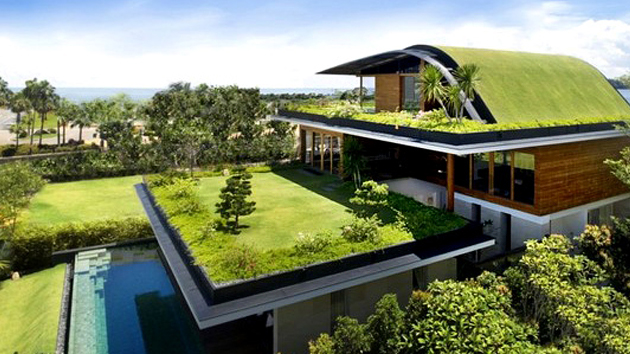In recent years, the concept of luxury in real estate has evolved beyond mere opulence and grandeur to encompass a new set of values—chief among them being environmental sustainability. Australia, renowned for its vast landscapes and natural beauty, is increasingly witnessing a shift in the preferences of luxury homebuyers towards properties that not only exude prestige but also adhere to stringent environmental standards. This article delves into the burgeoning trend of environmental and sustainability factors influencing the Australian luxury home market, exploring the reasons behind this shift, key considerations for buyers, impact on property values, and the broader implications for the real estate industry.

Evolution of Luxury Homebuying Trends
Traditionally, luxury homes were characterized by their size, location, and architectural grandeur, often overlooking considerations of environmental impact. However, as global awareness of climate change and resource depletion has heightened, so too has the demand for sustainable living solutions. This shift is particularly evident in Australia, where the effects of climate change—such as prolonged droughts, bushfires, and water shortages—have underscored the importance of responsible environmental stewardship.
Luxury homebuyers in Australia are increasingly prioritizing properties that integrate sustainable technologies and practices. These may include solar power systems, rainwater harvesting, energy-efficient appliances, passive design principles, and the use of recycled or renewable building materials. Beyond mere functionality, these features are now seen as essential components of a modern luxury home, reflecting a commitment to reducing environmental footprint and promoting long-term sustainability.
Key Environmental Factors Influencing Luxury Home Buying
1. Energy Efficiency and Renewable Energy
Energy-efficient homes not only lower operational costs but also contribute significantly to reducing carbon emissions. Features such as solar panels, smart home automation for energy management, and high-efficiency HVAC systems are highly valued by environmentally-conscious luxury buyers. In Australia, where abundant sunlight makes solar power particularly viable, homes equipped with solar panels are increasingly sought after for their potential to generate clean, renewable energy.
2. Sustainable Design and Materials
The use of sustainable building materials and design practices is another critical consideration for luxury homebuyers. This includes utilizing materials with low environmental impact, such as bamboo flooring, recycled timber, and environmentally certified paints and finishes. Sustainable design principles, such as passive solar orientation and natural ventilation, not only enhance energy efficiency but also promote a healthier indoor environment, which is particularly appealing to luxury buyers seeking both comfort and conscience.
3. Water Conservation and Management
Water scarcity is a pressing issue in many parts of Australia, particularly in regions prone to drought. Luxury properties that incorporate water-saving features like efficient irrigation systems, greywater recycling, and drought-resistant landscaping are increasingly valued. Buyers prioritize properties that not only minimize water usage but also contribute to the preservation of local water resources, aligning with broader sustainability goals.
4. Certification and Compliance
Certifications such as Green Star or LEED (Leadership in Energy and Environmental Design) provide independent verification of a property’s environmental performance. Luxury buyers often look for homes that meet or exceed these standards, as certification signifies a commitment to sustainability and adherence to rigorous environmental criteria. Compliance with local building codes and regulations related to sustainability also enhances the appeal and value of luxury properties in the Australian market.
Impact on Property Values and Market Dynamics
The integration of environmental and sustainability factors into luxury home design and construction has significant implications for property values and market dynamics in Australia. While initial costs associated with sustainable features may be higher, the long-term financial benefits—such as reduced utility bills and increased resale value—often outweigh these expenses. Properties with high energy efficiency ratings and sustainable certifications typically command premium prices in the market, reflecting growing consumer demand for environmentally responsible real estate.
Moreover, luxury developers and real estate agents are increasingly recognizing the marketing advantages of promoting sustainable features. Properties marketed as eco-friendly or sustainable attract a broader pool of affluent buyers who prioritize environmental responsibility alongside luxury and prestige. This trend not only drives competition among developers to innovate in sustainable design but also reshapes consumer expectations and preferences within the luxury segment of the real estate market.
Challenges and Opportunities for the Real Estate Industry
While the shift towards environmentally sustainable luxury homes presents opportunities for developers, architects, and investors, it also poses challenges. Integrating advanced technologies and sustainable practices into luxury home construction requires expertise and investment in research and development. Moreover, navigating regulatory frameworks and obtaining certifications can be complex and time-consuming, adding to project timelines and costs.
However, these challenges are outweighed by the potential benefits of catering to a discerning clientele increasingly motivated by environmental considerations. Developers who embrace sustainability not only future-proof their investments against regulatory changes and market shifts but also contribute positively to environmental conservation efforts. As sustainability becomes a hallmark of luxury living in Australia, the real estate industry is poised to play a pivotal role in advancing sustainable development practices and setting new standards for the global luxury market.
Conclusion
The incorporation of environmental and sustainability factors into Australian luxury home buying reflects a broader societal shift towards responsible consumption and environmental stewardship. As luxury buyers prioritize energy efficiency, sustainable design, and resource conservation, the real estate industry is responding with innovative solutions that redefine the concept of luxury living. From solar-powered residences to eco-friendly materials and water-saving technologies, sustainable luxury homes not only offer comfort and prestige but also contribute to a more sustainable future for generations to come.
In conclusion, the convergence of luxury and sustainability in Australian real estate signifies a transformative trend towards harmonizing human habitation with environmental preservation. As this trend continues to evolve, it promises to reshape the luxury home market, driving innovation, and influencing global perceptions of what constitutes a prestigious and socially responsible living environment. By embracing sustainability, luxury homebuyers in Australia are not only investing in their own future but also contributing to a more sustainable and resilient built environment for all.
